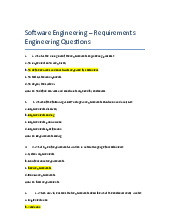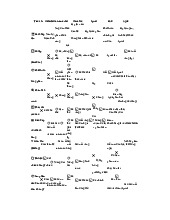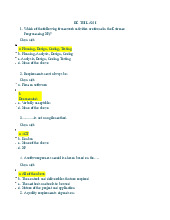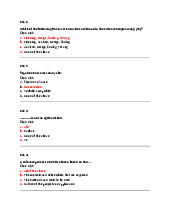


Preview text:
lOMoAR cPSD| 58886076
Classical Models – Mul ple Choice Quiz 1.
1. Which model fol ows a linear and sequen al approach? a. Incremental model b. V-model c. Waterfal model d. Spiral model Answer: Waterfal model 2.
2. In the Waterfal model, what phase comes immediately a er Design? a. Maintenance b. Implementa on c. Tes ng d. Deployment Answer: Implementa on 3.
3. Which model extends the Waterfal model by adding a corresponding test phase? a. RAD model b. V-model c. Itera ve model d. Spiral model Answer: V-model
4. 4. What is the main focus of the RAD model? a. Comprehensive documenta on b. Risk management c. Rapid development lOMoAR cPSD| 58886076 d. Security tes ng Answer: Rapid development 5.
5. Which model organizes development into loops that address the highest risk first? a. Incremental model b. RAD model c. Spiral model d. Waterfal model Answer: Spiral model 6.
6. What is a key difference between the Incremental and Itera ve models?
a. Incremental focuses on building ful features in increments, itera ve focuses on refining features
b. Itera ve model has no tes ng phase
c. Incremental model includes no customer feedback d. There is no difference
Answer: Incremental focuses on building ful features in increments, itera ve focuses on refining features 7.
7. Which phase is repeated in each itera on of the Itera ve model? a. Final deployment b. Requirement elicita on c. Tes ng d. Business modeling Answer: Tes ng 8.
8. In the Spiral model, what happens a er evalua ng risks? a. Deployment lOMoAR cPSD| 58886076 b. Start a new cycle
c. Develop a solu on and verify it d. Document requirements
Answer: Develop a solu on and verify it 9.
9. Why is the Spiral model considered suitable for large, high-risk projects? a. It skips design for speed
b. It combines prototyping and risk management c. It uses no tes ng phase d. It minimizes itera ons
Answer: It combines prototyping and risk management
10. 10. What is a poten al drawback of the V-model when compared to the Itera ve model? a.
It doesn't require test planning
b. It al ows changes at any stage
c. It lacks flexibility for requirement changes
d. It doesn't include any documenta on
Answer: It lacks flexibility for requirement changes



